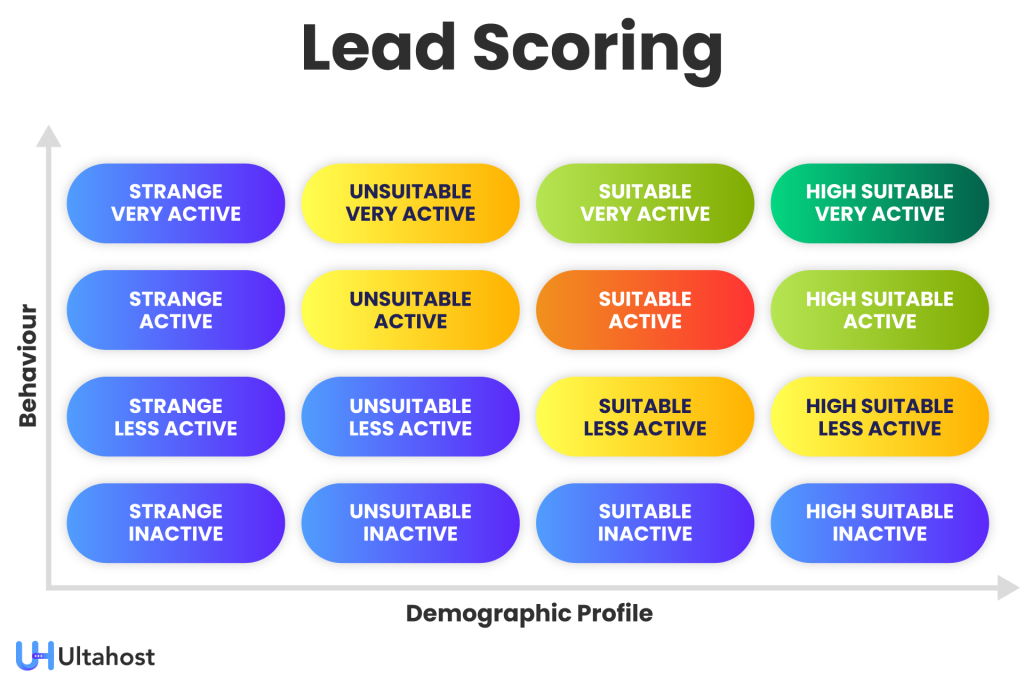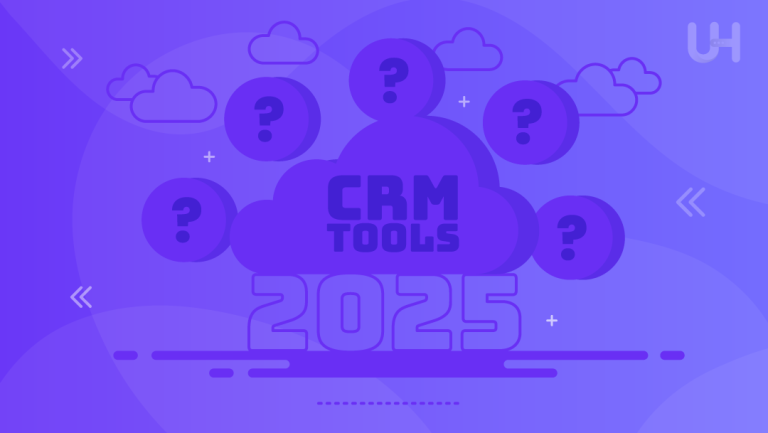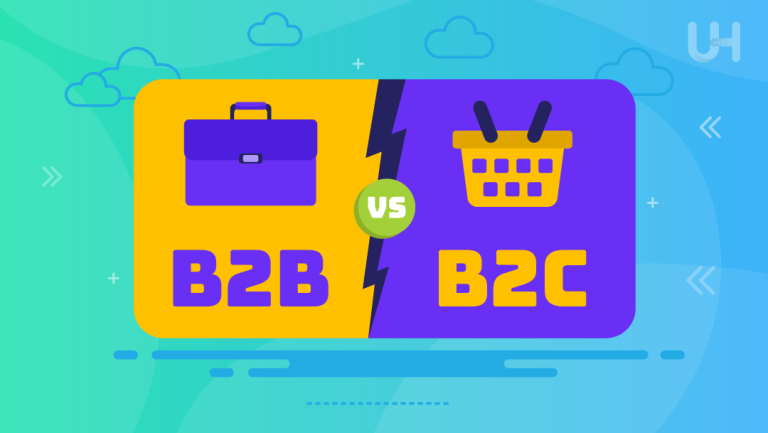Lead scoring is a crucial strategy that enables businesses to prioritize their sales efforts by ranking potential customers based on their conversion likelihood. Lead scoring is a process through which a sales team grades potential customers based on the probability of their buying. It is just a way of giving numbers to leads, depending on demographic information and behavioral interactions, to determine how good these leads are. This leads to quick identification of the quality of leads by a sales team. By working on leads with higher scores, businesses can have more chances for conversion.
Lead scoring is relevant here because it helps screen out and favor leads. In this highly competitive market, lead scoring would prove more effective in making optimum use of all the resources and the results obtained by the sales. Both B2B and B2C benefit from lead scoring; however, it is more essential for B2B because B2B has longer sales cycles that require a mature process to identify prospects.
Lead Scoring
Lead scoring is the process of ranking leads systematically. This means ranking leads based on the probability of them making a purchase. This will allow sales teams to determine which leads are most promising. With this, companies can focus their efforts on high-value prospects.
Lead scoring is a method used to score leads. It quantifies leads according to certain criteria. Such criteria mostly include demographic information, behavioral information, and engagement statistics. The aim is primarily to determine how ready the lead is to buy. Higher scores mean a higher probability of conversion. That way, sales teams can focus on outreach.
Components of Lead Scoring
Let’s discuss the components of lead scoring in detail:
Demographic Information
Demographic information is quite crucial in it. Age, job title, and industry may help understand the fit of a lead. For example, leads that come from target industries score higher. Job titles could also indicate decision-making authority. Understanding these demographics would help identify leads that best fit the business’s target market.
Behavioral Data
Behavioral data shows how leads interact with your brand. Visits to your website will help measure the level of interest. Leads who keep coming back to specific product pages are more likely to be intent-driven. The engagement through emails in terms of open rates and click-through rates also denotes interest. The depth of a lead’s interaction with your content may be reflected in the level of social media interactions. All these points lead to a better assessment of lead potentiality.

Engagement Metrics
Engagement metrics can be regarded as a direct activity of people interacting with the brand. Form submissions tell you whether or not somebody is interested and willing to commit. Content downloads inform you that leads are trying to find information about certain topics. Event attendance reveals a greater level of engagement or interest. Each of these gives you an idea of the readiness of a lead to further advance in the buying process.
The Importance of Lead Scoring
Lead scoring is one of the approaches that help in optimizing sales and marketing efforts, and significant benefits enhance overall efficiency and effectiveness. It enables firms to assess leads in light of their conversion potential to strategically prioritize resources and interaction. The key benefits of it are critical in leveraging this methodology for even better results in today’s competitive landscape.
Increases Sales Efficiency
Lead scoring dramatically enhances productivity because it ensures that focus among sales organizations is delivered exactly where potential leads become significant for conversions. Through sales representatives, a further refined list and quality list of leads input their time and energy so adequately. It focuses waste in meetings where much precious time is consumed by second-rated or inferior prospects, fostering massive frustration and burnout in sales representatives. Instead, the representatives direct their efforts towards leads with clear interest and chances improve greatly for closing deals. The sales teams would better their overall productivity and success by first engaging the high-scoring leads, hence better performances and results on sales will be achieved. Besides that, businesses also employ paid marketing campaigns and social media strategies to expand their audiences.
Improves Marketing Strategy
Lead scoring enhances the marketing strategy because marketers channel efforts based on the quality and readiness of leads. Lead scores will reveal to the marketers which parts of their audience need varying kinds of outreach and communication. This enables them to create the most targeted campaigns according to the needs and interests of each lead. A high-scoring lead might be ready to have a direct sales pitch, but a low-scoring lead requires more nurturing content. This alignment of marketing efforts with lead readiness not only boosts engagement rates but also enhances the overall customer journey. When leads receive messaging that speaks directly to their interests, they are more likely to respond positively and move further along the sales funnel stage.
Convert High-Quality Leads with the Right Hosting!
Lead scoring can transform your conversions, but reliable hosting is essential to support your growing business. Discover UltaHost’s powerful social network hosting solutions to keep your lead generation systems running smoothly and securely.
Better Resource Allocation
Good lead scoring facilitates better resource allocation among both the sales and marketing teams. It helps in strategically channeling efforts within an organization, offering clear lines of sight into the lead that would require the greatest amount of attention. For this reason, high-scoring leads are brought front and center for outreach and follow-up activities so that teams can plow their time and other resources into areas where perhaps they could make some creations. Automated social media, emails, personalized messages, and timely reminders will keep the lead engaged and move it to a purchase decision. A well-timed, strategic call to that inbound lead has almost incalculable power compared to the ability to make high numbers of cold calls or cold emails.
B2B Lead Scoring

B2B lead scoring evaluates leads specifically within the business-to-business context and differs from B2C lead scoring due to unique characteristics.
Characteristics and Importance
B2B lead scoring focuses on both leads and their organizations, considering factors like company size and the individual’s role in decision-making. This helps prioritize leads that match the target customer profile. Given the longer sales cycles in B2B, the scoring model should accommodate various buyer journey stages, emphasizing the value of nurturing leads over time. For B2C marketing, you can work your way with simple strategies and a website on a reliable VPS hosting server.
Collaboration and Challenges
Effective B2B lead scoring requires alignment between sales and marketing teams. Regular meetings help share insights on lead definitions and criteria. Challenges include complex decision-making processes and managing data quality.
Best Practices
To optimize scoring, utilize predictive analytics to identify conversion patterns and continuously adjust scoring criteria based on performance and market trends. By implementing these strategies, businesses can enhance efficiency, improve lead quality, and drive higher conversion rates in B2B markets. Other techniques include account based marketing (ABM) and personalized email campaigns also tailor the lead generation approach to the needs of each client. Lead generation channels include organic search (SEO), content marketing, social media marketing, paid advertising, and email marketing.
Types of Lead Scoring
Understanding the different types of lead scoring is essential for businesses looking to optimize their sales and marketing strategies. Indeed, each type serves a unique purpose and relies on various data sources to evaluate leads effectively. By recognizing these types, organizations can, therefore, implement a more nuanced and effective approach to lead management.
Explicit Lead Scoring
Explicit lead scoring focuses on data that leads provide directly. This type of scoring assesses demographic and firmographic information to gauge lead quality. Demographics include factors such as age, job title, and location, while firmographics cover company size, industry, and revenue. For example, a lead who holds a senior position in a target industry would receive a higher score than a lead from a less relevant sector. Beyond simply converting leads, effective lead nurturing will show enterprises exactly where they need to fine-tune their online sales strategy to potentially smooth the way for future new leads.
Sources of explicit data are diverse and can include forms, surveys, and third-party data providers. When leads fill out forms on your website, they typically provide information that can be used for explicit scoring. Surveys can also yield valuable insights about a lead’s needs and preferences. Additionally, third-party data sources can enrich lead profiles with relevant demographic and firmographic data. This rich dataset allows businesses to prioritize leads based on their fit within the target market. For example, if you have a real estate business, one effective way to attract potential leads is by choosing an attractive WordPress theme for a real estate business.
Implicit Lead Scoring
Implicit lead scoring relies on behavioral data to evaluate leads. This type of scoring analyzes how leads interact with your brand online. Key examples include website behavior, content interactions, and social media engagement. For instance, a lead who frequently visits product pages or downloads whitepapers demonstrates a higher level of interest than a lead who only opens emails occasionally.
Tracking lead behavior and engagement over time is crucial for implicit lead scoring. By monitoring interactions, businesses can identify trends and patterns that indicate a lead’s readiness to buy. This ongoing analysis allows sales and marketing teams to adapt their strategies based on lead behavior. Leads who show increased engagement may require immediate follow-up, while those with low engagement might benefit from nurturing campaigns to re-engage their interest.
Predictive Lead Scoring
Predictive lead scoring utilizes advanced analytics, including machine learning algorithms, to evaluate lead quality. This approach analyzes historical data patterns to predict which leads are most likely to convert. By processing vast amounts of data, predictive analytics can uncover hidden insights that traditional scoring methods may overlook.
The benefits of predictive analytics in identifying high-quality leads are substantial. It enhances the accuracy of lead scoring by considering multiple variables and their interrelationships. This method helps businesses focus on leads that exhibit behaviors aligned with previous successful conversions. As a result, sales teams can spend their time on leads with the highest potential, ultimately leading to increased sales efficiency and better resource allocation. Predictive lead scoring transforms the lead evaluation process, making it more data-driven and strategic.
Prioritize High-Quality Lead with Email Hosting
Discover how lead scoring can transform your sales process, then enhance your outreach with reliable email hosting. With the right Email Hosting at Ultahost, lead scoring helps you target the right leads.
How to Implement Lead Scoring
Implementing it effectively requires a strategic approach. Organizations need to establish clear criteria, assign appropriate scores, and integrate their systems for optimal results. Here’s a detailed guide on how to implement it in your business.
Identify Scoring Criteria
The first step in implementing it is identifying scoring criteria. Businesses should consider both demographic and behavioral factors.
- Demographic Factors: Demographic factors include information such as location, industry, and job title. Understanding where leads come from can help identify their potential fit. For example, a lead from a target industry is generally more valuable than one from an unrelated sector. Similarly, the lead’s job title can indicate their decision-making power within a company. Recognizing these demographics helps prioritize leads effectively.
- Behavioral Factors: Behavioral factors focus on how leads engage with your brand. Key metrics include the frequency of website visits and the type of content consumed. A lead who visits your website regularly demonstrates interest and engagement. Tracking which pages they visit or which content they download provides further insights into their needs. Understanding these behaviors enables businesses to tailor their outreach based on lead activity.
Assign Points to Each Criterion
After identifying the scoring criteria, the next step is to assign points to each criterion. This methodology involves determining positive and negative scores for different actions.
- Positive and Negative Scores: Assigning positive scores rewards leads to actions that indicate interest. For instance, a demo request might earn a lead 10 points, showing strong intent to engage. Conversely, negative scores penalize actions that indicate disinterest. For example, if a lead unsubscribes from your mailing list, it could result in a -5 score. This point system allows businesses to create a clear picture of lead quality.
Create a Scoring Model
Creating a scoring model is essential for structuring your lead scoring system. There are various models to choose from, each with its pros and cons.
Overview of Different Models
Simple Scoring Model: This model uses a basic point system to rank leads. It is easy to implement but may not account for the complexity of lead behaviors.
Advanced Scoring Model: This model incorporates multiple factors and may use predictive analytics. It provides a more nuanced view of lead quality but requires more resources to develop and maintain.
Pros and Cons of Each Model
- Simple Model Pros: Easy to set up and manage; clear and straightforward.
- Simple Model Cons: Lacks depth and may miss important insights; risk of oversimplifying lead quality.
- Advanced Model Pros: Offers detailed insights and improves accuracy; can adapt to changing conditions over time.
- Advanced Model Cons: More complex and requires data management resources; potential for overfitting if not monitored closely.
Integration with CRM Systems
Integrating lead scoring with Customer Relationship Management (CRM) systems is crucial for tracking interactions and scores. Seamless integration allows sales and marketing teams to access up-to-date lead information easily. With the perfect ERP and CRM in position, your business can handle the data load without any delay in operations.
Importance of Seamless Integration
Integration ensures that all lead activities are recorded accurately in real-time. As a result, this enables teams to respond promptly to high-scoring leads and maintain engagement with prospects. Additionally, a well-integrated system minimizes data silos, thereby allowing for better collaboration between departments.
Recommended CRM Tools
Several CRM tools support lead scoring effectively. Some popular options include:
- HubSpot: Offers built-in lead scoring features and easy integration with marketing automation.
- Salesforce: Provides customizable lead scoring options and robust analytics capabilities.
- Pipedrive: Focuses on sales processes and allows for efficient lead tracking and scoring.
Monitor and Adjust Scores
The final step in implementing lead scoring is, therefore, to monitor and adjust scores regularly. This practice ensures that the scoring system remains relevant in a changing market.
Techniques for Regular Updates
Businesses should conduct periodic reviews of scoring criteria and point assignments. Analyzing the performance of leads against actual conversions can highlight areas for adjustment. Additionally, feedback from sales and marketing teams can provide valuable insights into lead behavior and scoring accuracy.
Adapting to Changing Conditions
Market conditions and customer behaviors evolve; consequently, it is crucial to adapt your lead scoring system. By regularly adjusting scores based on new data and feedback, you can help maintain effectiveness. Furthermore, this proactive approach ensures that your lead scoring remains aligned with business objectives and market realities.
Best Practices for Lead Scoring
Implementing lead scoring effectively requires adherence to best practices. These practices ensure that the system functions optimally and continues to provide valuable insights. With the help of right tools, like a dedicated hosting service, marketing automation platforms, and analytics software, businesses can enhance their lead-scoring processes and achieve better results.

Collaboration Between Teams
Collaboration between sales and marketing teams is crucial for effective lead scoring. Alignment ensures that both teams share a common understanding of lead quality and scoring criteria. Regular meetings help facilitate this collaboration and create a culture of open communication.
Importance of Alignment
Sales and marketing teams must work together to define what constitutes a qualified lead. Marketing teams should provide insights into lead behavior, while sales teams can share feedback on lead quality based on their experiences. This synergy enables teams to adjust their strategies based on real-world interactions, improving overall lead quality.
Regular Meetings
Scheduling regular meetings allows teams to discuss lead quality and any necessary scoring adjustments. These meetings can serve as a platform to review high-scoring leads and assess whether the scoring criteria need refinement. By discussing insights and observations, teams can stay informed and adapt quickly to changes in lead behavior or market conditions.
Utilize Automation Tools
Utilizing automation tools streamlines the lead-scoring process. Automation helps maintain real-time scoring updates and alerts, ensuring teams have the most current information on leads.
Benefits of Automation
Automation reduces manual work and minimizes the risk of errors in lead scoring. With automated systems, businesses can track lead interactions seamlessly and update scores instantly. This real-time capability allows sales and marketing teams to respond quickly to high-scoring leads, enhancing engagement opportunities. Additionally, automation can generate alerts for leads that reach a certain score threshold, prompting timely follow-up.
Test and Iterate
Testing and iterating on lead scoring criteria and models is, therefore, vital for ongoing improvement. Additionally, A/B testing different approaches provides valuable insights into what works best for your organization.
Importance of A/B Testing
A/B testing allows businesses to compare the effectiveness of different scoring criteria or models. By implementing variations in scoring methods, teams can analyze which criteria correlate best with conversions. This empirical approach helps refine lead-scoring processes over time, making them more effective and aligned with business goals.
Train Your Team
Training your sales and marketing teams on the lead-scoring process is, therefore, essential for successful implementation. Moreover, educating team members ensures that everyone understands the criteria and methodologies used.
Educating Teams
Conducting training sessions helps team members grasp the importance of lead scoring. These sessions can cover how to interpret lead scores and the best practices for engaging leads based on their scores. A well-informed team is better equipped to leverage lead scoring effectively in their daily activities.
Continuous Learning and Adaptation
Lead scoring is not a one-time effort; instead, it requires continuous learning and adaptation. As market conditions and lead behaviors evolve, teams must therefore stay updated on best practices and emerging trends. Furthermore, regular training refreshers and updates on scoring criteria will help teams remain agile and responsive to changes, ensuring that lead scoring continues to deliver value over time.
Challenges in Lead Scoring
While lead scoring offers significant advantages, it also presents several challenges. Understanding these challenges is crucial for effectively managing and optimizing lead-scoring processes. Here’s a detailed overview of the common challenges businesses face in lead scoring and how to address them.
Data Quality Issues
Data quality is a significant concern in lead scoring. Inaccurate or outdated lead information can skew scoring results and lead to poor decision-making. Common problems include incorrect contact details, outdated job titles, and incomplete data profiles.
Common Problems
Inaccurate data can arise from various sources, such as leads providing incorrect information on forms or changes in job roles that go untracked. Additionally, outdated records can lead to engagement with leads who no longer fit the target market. Such issues can negatively impact scoring accuracy and overall lead quality.
Solutions for Maintaining Data Integrity
To combat data quality issues, businesses should implement regular data cleaning processes. This involves reviewing and updating lead information periodically to ensure accuracy. Utilizing data validation tools can also help capture correct information at the source. By maintaining data integrity, organizations can enhance the reliability of their lead-scoring systems.
Over-Reliance on Lead Scores
Over-reliance on lead scores can lead to a narrow focus on quantitative metrics, neglecting other qualitative aspects of leads. While scores provide valuable insights, they do not capture the full picture of a lead’s potential.
Risks of Neglecting Qualitative Aspects
Sales teams may prioritize outreach based solely on scores, missing opportunities for meaningful connections with leads. This approach, however, can result in overlooked prospects who may have strong potential but lower scores due to less traditional engagement methods. Furthermore, if businesses rely solely on scores, it can lead to disengagement, as leads may feel like just another number.
Strategies to Balance Scoring with Personal Outreach
To mitigate these risks, teams should balance lead scoring with personal outreach. Encourage sales representatives to review lead profiles and engage with leads based on interests, needs, and context. Personalizing communication and nurturing relationships can enhance conversion rates and lead satisfaction, creating a more holistic approach to lead management.
Complexity of Implementation
Implementing lead scoring can be complex; consequently, it can be particularly challenging when integrating it into existing workflows. Moreover, organizations may struggle with aligning scoring criteria and processes across teams.
Challenges in Integration
Integrating lead scoring into existing systems can involve technical hurdles and require collaboration between departments. Teams may face difficulties in standardizing criteria, resulting in inconsistencies in lead evaluation. Additionally, training staff on new processes can be time-consuming and challenging.
Tips for Simplifying the Lead Scoring Process
To simplify implementation, businesses should start with a clear and straightforward scoring model. Initially, they should define a limited number of criteria and then gradually introduce complexity as teams become comfortable with the process. Furthermore, utilizing intuitive CRM tools that support lead scoring can also streamline integration. Additionally, providing comprehensive training sessions will help ensure all team members understand the system and can use it effectively.
Changing Buyer Behaviors
Changing buyer behaviors poses another challenge for lead scoring. As market trends evolve, businesses must adapt their scoring models to remain relevant.
Adapting to Shifts in Buyer Behavior
Buyer behavior is influenced by various factors, including technological advancements and shifts in consumer preferences. For instance, leads may engage more through social media than traditional channels, impacting how their interest is measured. Organizations must stay attuned to these changes to adjust scoring criteria accordingly.
Importance of Flexibility in Scoring Models
Maintaining flexibility in scoring models is essential for staying relevant. Therefore, regularly reviewing and updating scoring criteria based on market trends and buyer feedback can ensure the model accurately reflects lead quality. Additionally, encouraging ongoing communication between sales and marketing teams will help identify shifts in buyer behavior and inform necessary adjustments. In this way, by remaining agile, businesses can effectively navigate changing landscapes and optimize their lead-scoring efforts.
Conclusion
Lead scoring significantly enhances marketing and sales efforts. It allows organizations to prioritize leads based on their likelihood to convert. This focus helps teams concentrate on the most promising prospects. As a result, businesses can improve efficiency and drive revenue growth.
Businesses must adopt effective lead-scoring strategies tailored to their needs. By refining these strategies, companies can align marketing and sales initiatives better. Readers should evaluate their current lead-scoring practices. Consider how to enhance these processes for improved lead quality and conversion rates. This reflection can position businesses for greater success.
For optimized performance, explore UltaHost’s CRM hosting solutions. With UltaHost, you’ll have the speed, security, and reliability needed to handle and nurture your leads at every stage. Start boosting your conversions today with UltaHost!
FAQ
What is lead scoring?
Lead scoring is a methodology used to rank leads based on their likelihood to convert into customers, considering factors like engagement and demographic data.
Why is lead scoring important?
Lead scoring helps businesses prioritize their sales efforts, allowing teams to focus on high-potential leads and improve conversion rates.
How does B2B lead scoring differ from B2C lead scoring?
B2B lead scoring often emphasizes firmographics and decision-making processes, while B2C focuses more on individual consumer behaviors and preferences.
What criteria should I use for lead scoring?
Common criteria include demographic information, behavioral data, engagement metrics, and interactions with marketing materials.
Can lead scoring be automated?
Yes, many CRM systems offer automation tools that can help calculate and update lead scores in real-time based on user-defined criteria.
How often should I update my lead scoring model?
It’s advisable to review and adjust your lead scoring model regularly—ideally every quarter or whenever significant market changes occur.
What challenges can arise in implementing lead scoring?
Common challenges include data quality issues, aligning scoring criteria across teams, and resistance to change from staff.













